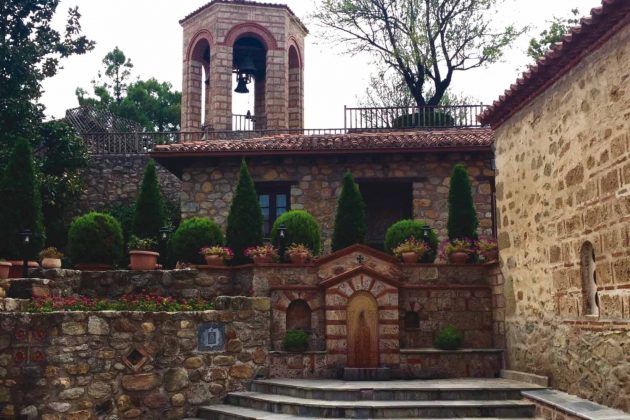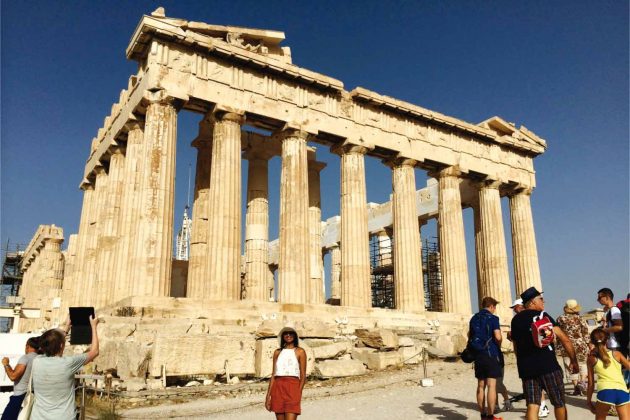This is the story of how I discovered a secret Greece that has been hiding from the world—the town of Meteora, located a few hours from Athens.
My dad was turning 70 in September. I don’t know about you, but that felt like a big deal birthday to me. Of course, I could have bought him yet another full sleeved shirt, or a brand-name watch, although he can’t even pronounce half those brands. Or I could have got him golf clubs… again. The clubs I got him for one birthday have collected so much dust sitting in the closet, there must be spiders weaving webs in there all day long. I was fast running out of ideas.
The “big deal” birthday gift
So what do you do when you don’t know what to get your dad for his big 70th? You book a flight to Greece! Well, it had also been my mom’s longtime desire to cruise the Greek isles, so I figured combining one parent’s desire with the other’s “big deal birthday” was a good enough excuse to hit the land of the Spartans. Given that it was mom’s dream destination, I relinquished trip planning control over to her. I knew we would be seeing Athens and Santorini but didn’t pay attention to the rest of the itinerary. I mean, what else was there to see besides the usual islands right?
September is supposed to be an ideal month, both crowd- and weather-wise, so we were looking forward to the cooler temperature.
Our first stop was Athens. I won’t wax poetic about the wonderful Parthenon—it was everything I expected it to be, but for the heat. I imagined a cool September breeze would caress my black tresses all day long except that my hair was stuck to my scalp most of the time, with rivulets of sweat running down my face and neck at intervals. Charming indeed.
Discovering Meteora
After a few days in Athens, we set off on a road trip my mom had arranged to some town called Meteora. The countryside during the drive was non-descript and we arrived within a few hours. Driving into town, we were immediately greeted by a rocky terrain. As we turned a corner along the windy road, I gasped at the sight that came into view. Soaring to the sky were these imposing rocks, and clinging to the edge was a beautiful building. We turned another corner and I spotted another stunning building perched atop the rocks. I was looking at several monasteries built on what were natural sandstone rock pillars. From afar, the monasteries appeared tiny as they clung for dear life to the rocks, and the whole area felt mystical and fairy-tale like.
Around 1344, Athanasios Koinovitis led a group of followers to Meteora to build this monastery. The only available means of reaching the monastery was climbing a long ladder, which was withdrawn whenever the monks sensed any threat.
The town is aptly named Meteora which in Greek means “suspended in the air.”
As I mentioned earlier, access to these monasteries was purposely difficult. In the 1920s, steps were cut into the rock, and you could access the monastery through a bridge. It’s fascinating that until the 17th century, the only way to send things and people across was by the baskets and ropes. Today, monasteries are tourist attractions and can be visited by steps— thank God for that, because I’m definitely not basket friendly!
We halted for a night at the charming Dellas Boutique hotel. The rooms were simple yet comfortable with balconies overlooking some mountains, while the breakfast spread was delicious. Imagine home-made jams of all sorts of flavours—I was definitely in jam heaven.
The majestic monasteries
After breakfast the next morning, we drove to the first of the three monasteries we were visiting. The Holy Monastery of Great Meteora is the oldest of them all. The central courtyard houses the main cathedral and is filled with beautiful 16th century frescoes. As we approached the summit, we were greeted with a spectacular view of the surrounding area and the Varlaam Monastery. We were able to visit the Sacristy inside as well as the old refectory of the monks, including the monastery’s old kitchen, complete with the original bread oven and soup hearth.
We drove by the Varlaam Monastery but since it was closed, we proceeded toward the Roussanou Monastery, said to have received the name of the first hermit who settled on the rock. Now compared to the other monasteries, this one is on a lower elevation and more accessible. We were greeted by a nun who was providing scarves for anyone needing to cover their bare shoulders. Don’t miss the beautiful wall-paintings of the Catholican.
As I stepped inside the Sacristy, I wondered how these nuns and monks chose to stay in seclusion, away from the rest of civilisation. I sat down for a while; an immense sense of peace washed over me. I wondered briefly if I could trade in the chaos of the outside world for a quiet existence like this one.
The peace was palpable
As I sat at the town square later that evening, watching the little kids actually play with one another, instead of their face glued to some hand-held device, I realised everyone in the square was interacting with each other. I even saw a little girl pushing a baby stroller with a doll inside, around the park. That’s a sight I don’t see in the parks around San Francisco, where I currently live.
I watched in fascination, here in the park I felt that same sense of peace I had felt while sitting inside the Sacristy of the monastery. Technology still hadn’t taken over every single waking moment in Meteora and I truly felt aware of my surroundings.
As we continued on our road trip toward Delphi, I realised I had just seen the jewel of Greece, a little off the beaten path town called Meteora, now a UNESCO World Heritage Site. Experiential moments like these can be found even in a heavily tourist inundated country like Greece—you just have to be open to walking on the road less travelled.
This was first published in the May 2016 issue of Complete Wellbeing.







